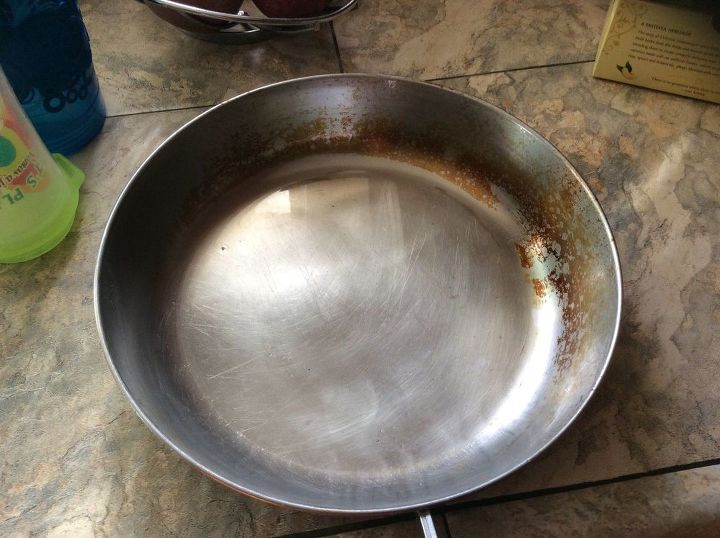My front load washer is stinky, how can I get rid of the smell?
Related Discussions
How to clean a mirror without streaks?
Every time I clean my mirrors, they end up having tons of streaks and almost look worse than before I started. What could I use to clean them that won't leave streaks... See more
How to clean burns on stainless steel pans?
Help! I burned my pan. How do I clean stainless steel cookware that's been burned?
How to clean shower doors
How to clean glass shower doors
How to clean hardwood floors in the kitchen?
What is the best way to clean hardwood floors in the kitchen?
How to clean my kitchen cabinets from grease?
My kitchen cabinets are embarrassingly greasy. Please share your degreasing tips with me so I don't have to cringe every time I glance at my cabinets.
My fridge stinks and I can't get rid of the smell! Any ideas???
I had crab legs in the fridge and some of the liquid leaked...now it smells like fish. I have wiped and sprayed and it still smells! Any ideas???
I'd like to know how I can get rid of adult urine smell from my home
My husbands mother is staying with us and wears diaoers and she smells very bad and the room she is in and washroom she uses basically my house plz help I ave tried a... See more


sometimes the detergent cups need cleaned you can run 5 cups bleach thru cycle i would run a couple more to make sure bleach is gone crack the door open also after use
Why your washing machine smells, and how to clean it
When we think of washing machines, we think of clean, fresh-smelling clothes. Laundry is supposed to have a comforting aroma—one that’s so well-loved that there are even colognes designed to mimic its scent.
But what do you do when your front-load washer, well... stinks?
Before you resign yourself to a musty, mildewy, sour-scented existence, consider this: Your washer probably isn’t defective—it just needs some TLC. A few simple steps could help eliminate that stench forever.
That’s right, my friends: It’s all smooth, fresh-smelling sailing from here on out. Grab your hampers, keep your heads high, and scrub stinky clothes from your life for good.
Why your front-loader stinks
I took an in-depth look at the relative performance of front- and top-load washers, and found that front-loaders are superior in virtually every way. That came as no surprise, since front-loaders are designed not only to be more efficient, but also to be gentler on clothes while cleaning them better.
But it's that efficiency part that can cause some headaches when it comes to smell. See, high-efficiency front-loaders use a lot less water than their top-load counterparts, since they fill just the bottom of the wash tub with water. Since the drum rotates on a horizontal axis, your clothes tumble through the water, eliminating the need to fill the tub up all the way.
That's all fine and dandy if you use high-efficiency detergents, but when you douse your laundry with the wrong kinds of soap and softeners, the smaller amount of water can’t fully rinse them away. The drum ends up getting coated with a layer of soap scum, which is itself peppered with debris and dirt from your clothing. In the heat and damp of your washer, this scum makes a happy home for mildew, bacteria, and mold.
The stinky situation is compounded by the fact that front-load washers use a rubber door gasket to keep water from leaking out. Dirt, soap, and bits of fabric can get trapped under the gasket, creating yet another breeding ground for nasty smells.
How to get rid of that smell
1. Bring out the baking soda.
Your first inclination may be to reach for the bleach, but I prefer to use something a little gentler. I suggest mixing 1/4 cup of baking soda with an equivalent amount of water. Add this solution to your machine’s detergent container.
2. Bring out the vinegar.
Pour two cups of white vinegar into the drum, then run a normal cycle at high heat—without any clothes, of course.
The baking soda and vinegar should break up any residue stuck to your drum and kill any mold that might be present. They’ll also help remove any foul odors.
3. Scrub away any remaining grime.
If stubborn spots remain, attack them with the rough side of a kitchen sponge and a mixture of one part white vinegar, one part water. Ta-dah, good as new!
You can repeat this cleaning method once a month for maintenance if you’d like, or try some other odor prevention techniques.
How to keep your front-loader fresh
Your washer is finally free of nasty odors, and you want to keep it that way. But how?
1. Break up with your old detergent.
If you own a front-loader, you should always use detergents made for high-efficiency machines. Normal detergents simply produce more suds than your front-loader can handle; less suds means less scum for stinky lifeforms to cling to. Liquid fabric softener is also off-limits for front-loading washing machines, so do yourself a favor and ditch it.
2. Keep the drum dry
Once you’ve got the soap situation under control, it’s time to make sure the drum doesn’t stay damp for long periods of time. Always remove your laundry promptly after the cycle ends, and be sure to leave the door open when it’s not in use, so the moisture can escape.
You can also run a fan in the room where your washer lives to improve airflow, and consider investing in a dehumidifier. Remember: You don't want bacteria or mold to feel at home here, and nothing invites bad smells quite like wet, stagnant heat.
3. Clean the gasket.
Even with the correct detergent and anti-humidity efforts, there's no guarantee your washer drum won't develop some mold-friendly buildup. The rubber seal around the doors is especially problematic, so you should regularly remove any debris you see trapped in the gasket and wipe it down with a cleaning solution made of one part white vinegar and one part water.
Finally, be sure to dispose of any lint that may have accumulated in your machine’s drain trap filter. Once a week should do the trick.
Ditto to the above answer.. I personally put a small amount of baking soda with most washes.. Then always, always leave your door open. We contacted the mfg co. who said these machines leave a small amount of water in the bottom under the drum. that's where it lives, along with the rubber gasket and the drum.. I personally wash my whites with a small amount of bleach to clean Chefs coats.. The vinegar wash works but, not completely to me personally... hope this helps.. By the way this what our MFG Co. suggested.
If you're using sofener I agree with trying without. I don't use sofener, but, do put in about 25gms of soda crystals with each wash, and then once a month put it through a 95oc wash with about 300gm soda crystal (and after any particularly heavy wash, e.g pet blankets, sports wear.) Also, if you're in a hard water area you can reduce your laundry detergent to the soft water amt with adding soda crystals.
If you're using sofener I agree with trying without. I don't use sofener, but, do put in about 25gms of soda crystals with each wash, and then once a month put it through a 95oc wash with about 300gm soda crystal (and after any particularly heavy wash, e.g pet blankets, sports wear.) Also, if you're in a hard water area you can reduce your laundry detergent to the soft water amt with adding soda crystals.
Ditto to the above comments...and I leave my dispenser drawer open too. It helps to dry up all the water that may be lurking in small places other than the in the bottom of the machine.
You likely have water standing in and souring in your washer. Leave the door open for it to be able to dry -- even consider hand turning it a few times to splash the water onto the drum rather than leave it in a puddle if you're not going to be doing laundry again that day.
If you need to remove smells from clothes, you could add some Mr. Clean -- it doesn't add a bunch of suds but can remove smells laundry soaps don't.
Thanks for the Mr. Clean hint. I do turn the drum while getting the clothes out. I
dry out the washer each time I use it and clean around the gasket. I leave the door and detergent drawer open. I never in a million years thought I would have to do this much work on a washing machine. My top loader was cleaned about 4 times a year, and lasted 15 years with no problems. I do not like this front loader, but to replace it is so costly.